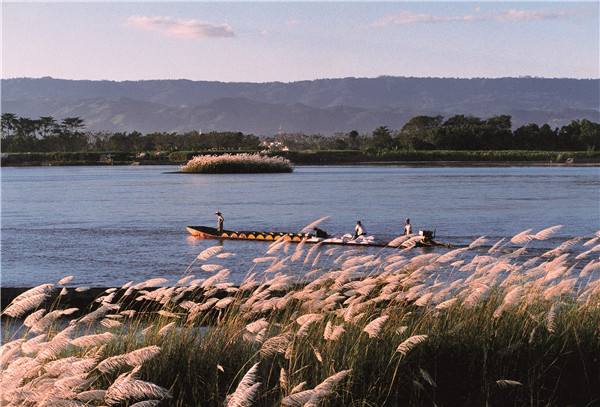
Ruili River in Dehong
Chinese Name:德宏瑞丽江
English Name: Ruili River in Dehong
Overview
The Ruili River is a significant river flowing through tropical regions and valleys. The river is divided into three sections, each offering distinct scenic beauties. The drainage area of the Ruili River is rich in tourism resources, featuring a variety of scenic spots. It is known for its tropical and subtropical landscapes, border ports, ethnic cultures, and historical significance.
Historical Names and Importance
- Ancient Name: In the Dai language, the river was historically known as the Nanmao River, meaning “Mist Water River.”
- Other Names: During the Yuan and Ming dynasties, it was called the Luxuan River, and in the Qing Dynasty, it was known as the Longchuan River or the Ruili River.
- Significance: The Ruili River irrigates fertile lands across China and Myanmar, supporting nearly a million people. It flows from the western side of Gaoligong Mountain in Tengchong County, passing through Longchuan, Lianghe, and other counties, and eventually flows into Myanmar before merging with the Irrawaddy River.
Geographical Details
- Length in China: 53 kilometers
- Width: 100-200 meters
- Sections: The river features different scenic sections including the flat plains around Ruili and the narrow, canyon-like sections.
Tourism Status
- National Scenic Area: Approved as a national scenic spot by the State Council on January 10, 1994, and listed among the third batch of national key scenic spots.
- Scenic Level: Third batch of national key scenic areas.
Key Attractions
- Tiger Jumping Stone: A notable scenic spot along the river.
- Wildlife: Includes white-handed gibbons, green peacocks, and various tree species like the Saro tree and rock cotton tree.
- Scenic Highlights: Lush tropical rainforests, clear springs, and picturesque river views with abundant wildlife.
Protected Area
- Establishment: The Ruili River Nature Reserve was established in March 1992, covering areas in Ruili, Mangshi, and Longchuan.
- Flora and Fauna: The reserve features a transition zone from seasonal rainforests to evergreen broadleaf forests, with over 600 plant species and 216 vertebrate species. It is also the source of several rivers such as the Mengyue, Nanhun, Mangbang, and Nanlan Rivers.
- Area: 73,500 hectares, designated as a provincial nature reserve in May 2002.
Tourism Resources
- Landscape: The Ruili River’s surroundings are known for their clear waters, lush bamboo forests, and charming rural scenery. Traditional Dai-style bamboo houses dot the riverbanks amidst flowing streams and fertile fields.
- Scenic Beauty: The river’s tropical rainforest is vibrant, with exposed tree roots blending with the rock faces. The clear springs and picturesque river scenes are enchanting.
- River Sections: The Ruili section features flat river plains with scenic views of the river widening and offering a refreshing experience. The river is partly a border river between China and Myanmar, with serene waters, reflecting light, and flocks of wild ducks, egrets, gray cranes, and kingfishers. Boats, bamboo rafts, and motorboats transport goods and people between the two countries.
Drifting and Boating
- Drifting Sections: The river is ideal for drifting and boating, particularly in the Zhefang and Wanting sections. The Zhefang section offers wide, calm waters suitable for various activities. The Wanting section is narrower, with lush vegetation and dramatic landscapes.
Best Time to Visit
- Season: The best time to visit is during the dry season from October to April when the weather is cooler and more comfortable.
- Avoid: The rainy season from May to September may lead to less favorable conditions for outdoor activities.
Accommodation
- Nearby Towns: Accommodation options are available in nearby towns such as Ruili, Baoshan, and Dali.
- Types: Options range from budget hotels to more upscale resorts.
Travel Tips
- Preparation: Bring appropriate clothing and footwear for outdoor activities and water-based adventures.
- Local Customs: Respect local customs and practices, especially in ethnic minority villages.
- Weather Check: Verify the weather conditions before your trip for a more enjoyable experience.
The Ruili River offers a unique blend of tropical and subtropical landscapes, cultural heritage, and natural beauty, making it a captivating destination for nature lovers and cultural enthusiasts alike.

 7 Days GolfingTour
7 Days GolfingTour
 8 Days Group Tour
8 Days Group Tour
 8 Days Yunnan Tour
8 Days Yunnan Tour
 7 Days Shangri La Hiking
7 Days Shangri La Hiking
 11 Days Yunnan Tour
11 Days Yunnan Tour
 6 Days Yuanyang Terraces
6 Days Yuanyang Terraces
 11 Days Yunnan Tour
11 Days Yunnan Tour
 8 Days South Yunnan
8 Days South Yunnan
 7 Days Tea Tour
7 Days Tea Tour
 8 Days Muslim Tour
8 Days Muslim Tour
 12 Days Self-Driving
12 Days Self-Driving
 4 Days Haba Climbing
4 Days Haba Climbing
 Tiger Leaping Gorge
Tiger Leaping Gorge
 Stone Forest
Stone Forest
 Yunnan-Tibet
Yunnan-Tibet
 Hani Rice Terraces
Hani Rice Terraces
 Kunming
Kunming
 Lijiang
Lijiang
 Shangri-la
Shangri-la
 Dali
Dali
 XishuangBanna
XishuangBanna
 Honghe
Honghe
 Kunming
Kunming
 Lijiang
Lijiang
 Shangri-la
Shangri-la
 Yuanyang Rice Terraces
Yuanyang Rice Terraces
 Nujiang
Nujiang
 XishuangBanna
XishuangBanna
 Spring City Golf
Spring City Golf
 Snow Mountain Golf
Snow Mountain Golf
 Stone Mountain Golf
Stone Mountain Golf















